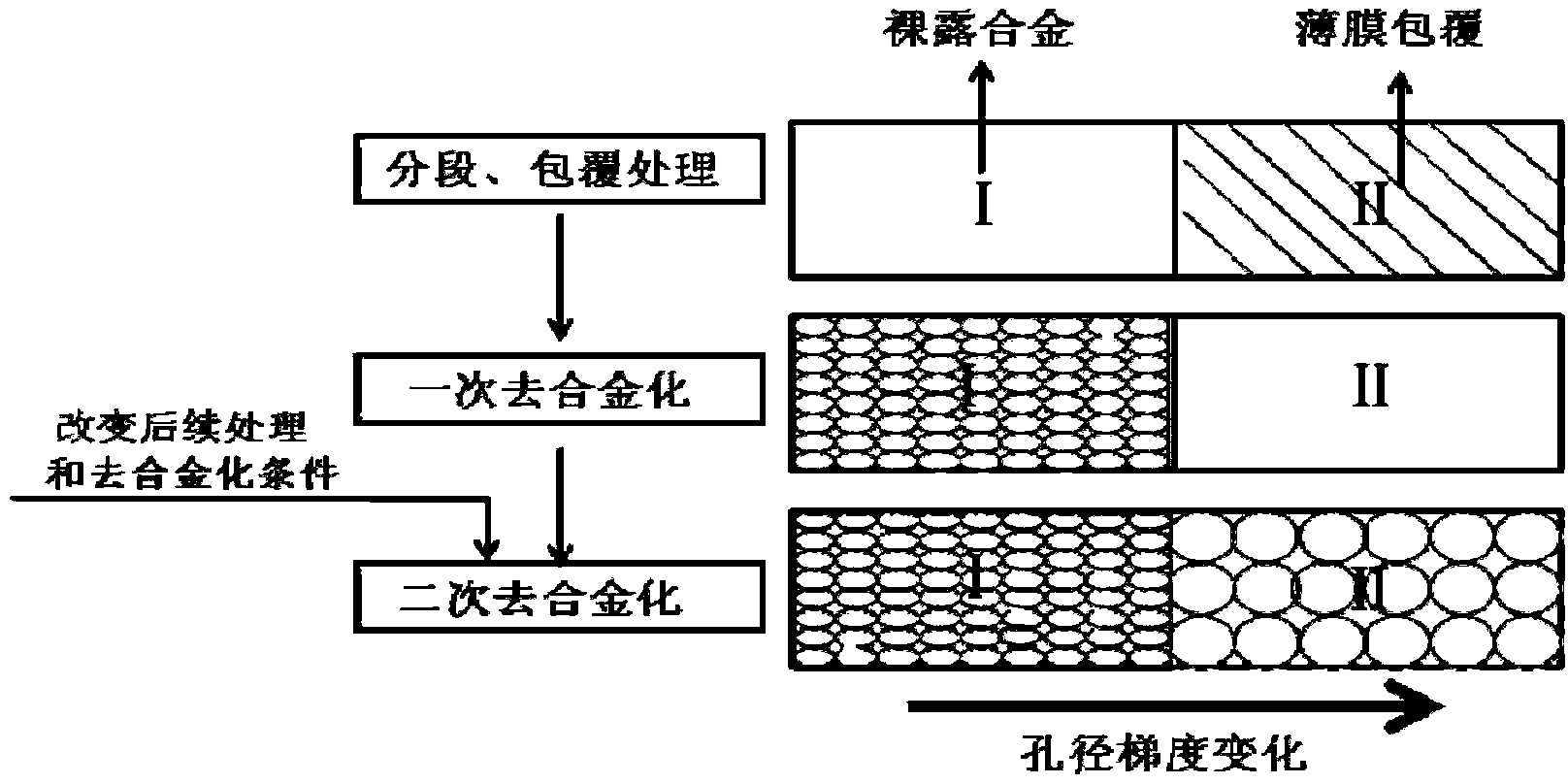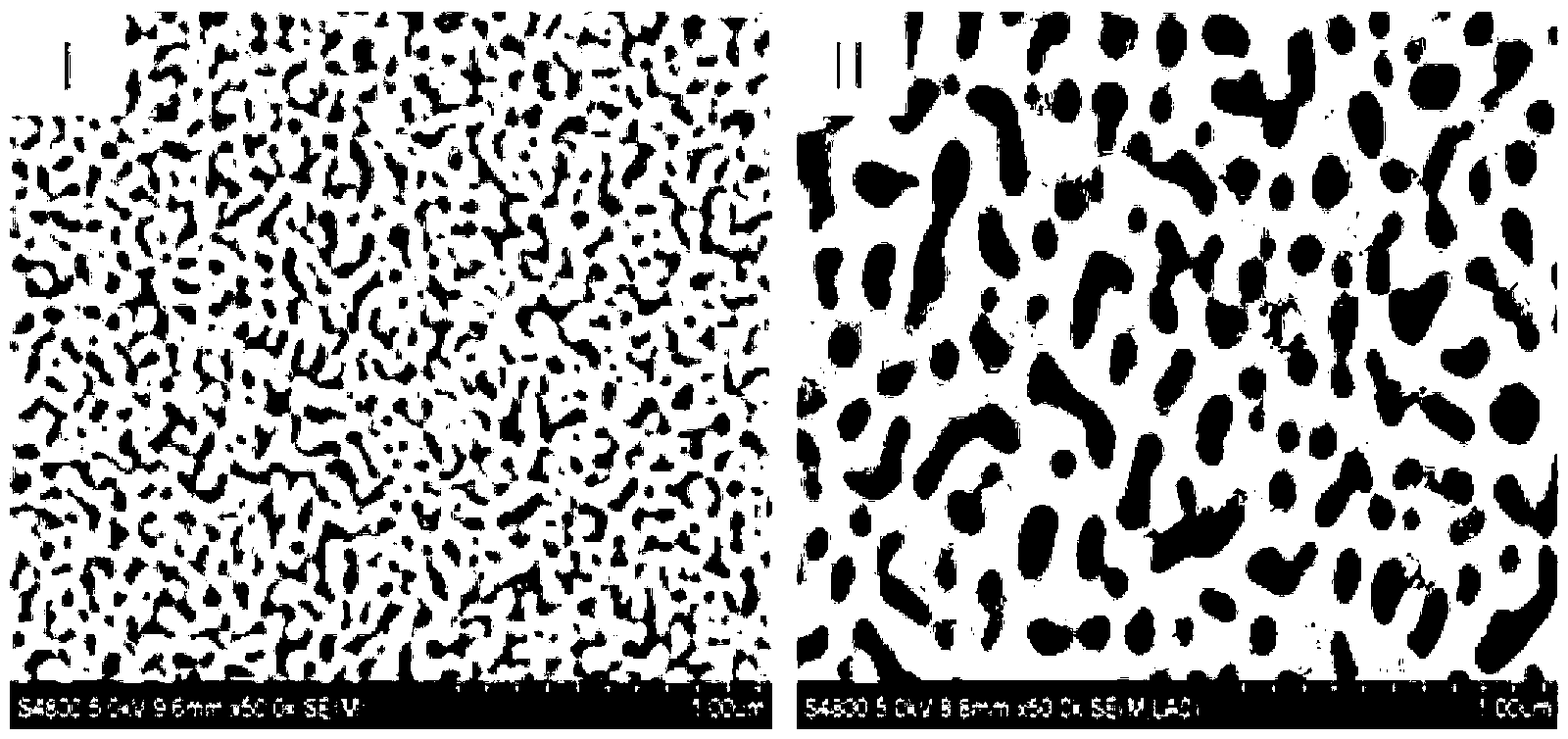Nano-porous metal material with gradient changes in aperture and preparation method thereof
A gradient change, nano-porous technology, applied in the field of nano-metal functional materials, can solve the problems of not having a pore structure and a gradient distribution of porosity, and achieve excellent physical and chemical properties, wide application range, and broaden the range.
- Summary
- Abstract
- Description
- Claims
- Application Information
AI Technical Summary
Problems solved by technology
Method used
Image
Examples
Embodiment 1
[0048] (1) Preparation of precursor alloy
[0049] Silver flakes with a purity of 99.99% and zinc particles with a purity of 99.99% are used as raw materials, and the silver flakes and zinc particles are measured according to the atomic ratio of silver to zinc = 25:75.
[0050] Put the measured raw materials into the crucible of the vacuum magnetic induction melting furnace, and evacuate the furnace to a vacuum degree of 5×10 -3 Pa, then fill the furnace with argon all the time, keep the pressure in the furnace at 0.5 atmospheres, energize the crucible to melt the raw materials, cut off the power after 10 minutes of heat preservation, and let the alloy melt naturally cool to room temperature in the crucible to obtain the cast alloy ingot . The as-cast alloy ingot is placed in a tube furnace protected by an argon atmosphere and kept at 550°C for one week. After the holding time expires, it is taken out and rapidly cooled in cold water to obtain a solid solution alloy ingot.
...
Embodiment 2
[0060] (1) Preparation of precursor alloy
[0061] The nickel block with a purity of 99.9% and the electrolytic manganese sheet with a purity of 99.9% are used as raw materials, and the nickel block and electrolytic manganese sheet are measured according to the atomic ratio of nickel to manganese = 45:55.
[0062] Put the measured raw materials into the crucible of the vacuum magnetic induction melting furnace, and evacuate the furnace to a vacuum degree of 5×10 -3 Pa, then fill the furnace with argon all the time, keep the pressure in the furnace at 0.5 atmospheres, energize the crucible to melt the raw materials, cut off the power after keeping it warm for 10 minutes, and let the alloy melt naturally cool to room temperature in the crucible to obtain the cast alloy ingot . The as-cast alloy ingot was placed in a tube furnace protected by an argon atmosphere and kept at 900°C for 48 hours. After the holding time expired, it was taken out and rapidly cooled in cold water to o...
Embodiment 3
[0072] (1) Preparation of precursor alloy
[0073] Cobalt blocks with a purity of 99.99% and aluminum ingots with a purity of 99.9% are used as raw materials, and the cobalt blocks and aluminum ingots are measured according to the atomic ratio of cobalt to aluminum = 4:6.
[0074] Put the measured raw materials into the crucible of the vacuum magnetic induction melting furnace, and evacuate the furnace to a vacuum degree of 5×10 -3 Pa, then fill the furnace with argon all the time, keep the pressure in the furnace at 0.5 atmospheres, energize the crucible to melt the raw materials, cut off the power after 10 minutes of heat preservation, and let the alloy melt naturally cool to room temperature in the crucible to obtain the cast alloy ingot . Put the as-cast alloy ingot in a tube furnace protected by an argon atmosphere and keep it warm at 950°C for 40 hours. When the holding time expires, take it out and quickly cool it in cold water to obtain a solid solution alloy ingot. ...
PUM
| Property | Measurement | Unit |
|---|---|---|
| pore size | aaaaa | aaaaa |
| thickness | aaaaa | aaaaa |
| thickness | aaaaa | aaaaa |
Abstract
Description
Claims
Application Information
 Login to View More
Login to View More - R&D
- Intellectual Property
- Life Sciences
- Materials
- Tech Scout
- Unparalleled Data Quality
- Higher Quality Content
- 60% Fewer Hallucinations
Browse by: Latest US Patents, China's latest patents, Technical Efficacy Thesaurus, Application Domain, Technology Topic, Popular Technical Reports.
© 2025 PatSnap. All rights reserved.Legal|Privacy policy|Modern Slavery Act Transparency Statement|Sitemap|About US| Contact US: help@patsnap.com



